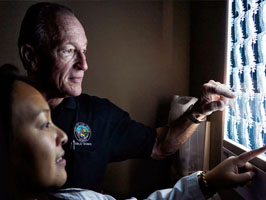Overview and Indications
Posterior Cervical Fusion (PCF) is the general term used to describe the technique of surgically mending two (or more) cervical spine bones together along the sides of the bone using a posterior (back of the neck) incision. Bone graft is placed along the sides the spine bones, which over time, fuses (mends) together. PCF may be performed in conjunction with or without a posterior decompression (laminectomy) and/or instrumentation (use of metal screws/rods). Nowadays, metal screws and rods are almost always used, which adds immediate stability and increases the fusion rate (percentage of patients where the bone successfully mends together).
PCF is most commonly performed for patients with cervical fractures or instability, but is also performed for a variety of other spinal conditions, such as tumors, infections, and deformity. PCF may also be performed in conjunction with anterior cervical surgery, especially when multiple levels are involved.
Surgical Technique
The surgery is performed utilizing general anesthesia. A breathing tube (endotracheal tube) is placed and the patient breathes with the assistance of a ventilator during the surgery. Preoperative intravenous antibiotics are given. Patients are positioned in the prone (lying on the stomach) position, generally using a special operating table/bed with special padding and supports. The surgical region (neck area) is cleansed with a special cleaning solution. Sterile drapes are placed, and the surgical team wears sterile surgical attire such as gowns and gloves to maintain a bacteria-free environment.
A 3-6 inch (depending on the number of levels) posterior (back of the neck) longitudinal incision is made in the midline, directly over the involved spinal level(s). The fascia and muscle is gently divided, exposing the spinous processes and spine bones. An x-ray is obtained to confirm the appropriate spinal levels to be fused. A laminectomy (removal of lamina portion of bone) and foraminotomy (removal of bone spurs near where the nerve comes through the hole of the spine bone) can be performed if necessary. Two small metal screws can be affixed to each spine bone, one on each side, which are then connected together with a titanium metal rod on each side of the spine. The bony surfaces and facet joints are then decorticated and bone graft is placed, which mends together over time (weeks and months).
The wound area is usually washed out with sterile water containing antibiotics. The deep fascial layer and subcutaneous layers are closed with strong sutures. The skin can usually be closed using sutures or staples. A sterile bandage is applied.
The total surgery time is approximately 2-4 hours, depending on the number of spinal levels involved.

